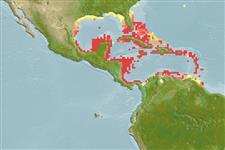>
Eupercaria/misc (Various families in series Eupercaria) >
Scaridae (Parrotfishes) > Scarinae
Etymology: Scarus: Greek, skaros = a fish described by anciente writers as a parrot fish; 1601 (Ref. 45335).
More on authors: Bloch & Schneider.
Environment: milieu / climate zone / depth range / distribution range
Écologie
marin récifal; profondeur 3 - 25 m (Ref. 9710). Tropical; 33°N - 8°N, 98°W - 59°W
Western Central Atlantic: Bermuda, Florida (USA), and Bahamas to northern South America; throughout the Caribbean Sea.
Taille / Poids / Âge
Maturity: Lm ? range ? - ? cm
Max length : 61.0 cm TL mâle / non sexé; (Ref. 7251); common length : 32.0 cm TL mâle / non sexé; (Ref. 3802)
Épines dorsales (Total): 9; Rayons mous dorsaux (Total): 10; Épines anales 3; Rayons mous anaux: 9. Young adults of both sexes dark gray overall, with broad white stripe slightly below mid-side. Super males have upper pectoral fin margin and upper and lower margins of tail dusky with submarginal band of brownish orange (Ref. 26938).
Inhabits coral reefs and adjacent habitats. Feeds on algae scraped from rocks or dead coral. Sleeps in a mucus cocoon (Ref. 9710). Often seen in groups of one super male with several young adults, most of which are probably females (Ref. 26938). A protogynous hermaphrodite (Ref. 55367).
Life cycle and mating behavior
Maturité | Reproduction | Frai | Œufs | Fécondité | Larves
Forms permanent harem groups composed of a single male and several smaller females (Ref. 55367). A monandric species (Ref. 55367). Length at sex change = 25.2 cm TL (Ref. 55367).
Robins, C.R. and G.C. Ray, 1986. A field guide to Atlantic coast fishes of North America. Houghton Mifflin Company, Boston, U.S.A. 354 p. (Ref. 7251)
Statut dans la liste rouge de l'IUCN (Ref. 130435)
Menace pour l'homme
Reports of ciguatera poisoning (Ref. 30911)
Utilisations par l'homme
Pêcheries: intérêt commercial mineur; Aquarium: Commercial
Plus d'informations
RéférencesAquacultureProfil d'aquacultureSouchesGénétiqueElectrophoresesHéritabilitéPathologiesTraitementNutrientsMass conversion
Outils
Articles particuliers
Télécharger en XML
Sources Internet
Estimates based on models
Preferred temperature (Ref.
123201): 26.2 - 28.2, mean 27.4 °C (based on 528 cells).
Phylogenetic diversity index (Ref.
82804): PD
50 = 0.5000 [Uniqueness, from 0.5 = low to 2.0 = high].
Bayesian length-weight: a=0.01445 (0.00686 - 0.03044), b=3.03 (2.86 - 3.20), in cm total length, based on LWR estimates for this Genus-body shape (Ref.
93245).
Niveau trophique (Ref.
69278): 2.0 ±0.00 se; based on food items.
Generation time: 1.8 ( na - na) years. Estimated as median ln(3)/K based on 1
growth studies.
Résilience (Ref.
120179): Haut, temps minimum de doublement de population inférieur à 15 mois (K=0.6).
Fishing Vulnerability (Ref.
59153): Low to moderate vulnerability (28 of 100).
Nutrients (Ref.
124155): Calcium = 34.6 [22.3, 60.2] mg/100g; Iron = 0.758 [0.526, 1.144] mg/100g; Protein = 18.8 [16.7, 20.6] %; Omega3 = 0.0836 [, ] g/100g; Selenium = 21.8 [13.9, 34.1] μg/100g; VitaminA = 32.1 [9.6, 110.6] μg/100g; Zinc = 1.95 [1.48, 2.53] mg/100g (wet weight);
